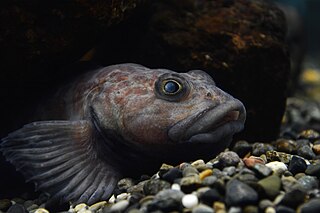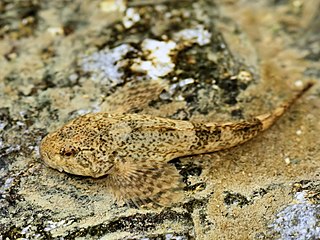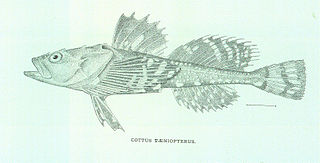
The Cottidae are a family of fish in the superfamily Cottoidea, the sculpins. It is the largest sculpin family, with about 275 species in 70 genera. They are referred to simply as cottids to avoid confusion with sculpins of other families.

The Abyssocottinae are a subfamily of ray-finned fishes in the family Cottidae, the sculpins. They are known commonly as the deep-water sculpins. The entire subfamily is endemic to Lake Baikal in Siberia.

The spoonhead sculpin is a species of freshwater ray-finned fish belonging to the family Cottidae, the typical sculpins. This species is widespread in northeastern North America.

The deepwater sculpin is a species of freshwater fish in the family Cottidae of order Scorpaeniformes. It is a glacial relict, native to a limited number of deep, cold lakes in Canada and the United States.

The slimy sculpin is a freshwater species of fish belonging to the family Cottidae, which is the largest sculpin family. They usually inhabit cold rocky streams or lakes across North America, ranging from the Great Lakes, southeast Minnesota, northeast Iowa, southwest Wisconsin and northeast Canada. Slimy sculpins have also been found roaming the cold streams of eastern Siberia. They are commonly confused with their closely related relatives, Mottled sculpin, and with tubenose gobies who are both freshwater fishes as well. The slimy sculpin is a nocturnal fish that usually spends most of its time on the stream bottom and seeks shelter under rocks and logs, especially during spawning season. When it swims, it sometimes appears to be "hopping" along the bottom because of its inefficient ability to swim. This is partly due to the absence of a swim bladder, which normally gives buoyancy to a fish.

Cottus is a genus of the mainly freshwater ray-finned fishes belonging to the family Cottidae, the typical sculpins. They are often referred to as the "freshwater sculpins", as they are the principal genus of sculpins to be found in fresh water. They are native to the Palearctic and Nearctic.

The Pacific staghorn sculpin is a species of marine ray-finned fish belonging to the family Cottidae, the typical sculpins. This species is found in the eastern Pacific Ocean. It is the only species in the monospecific genus Lepidocottus.

The European bullhead is a freshwater fish that is widely distributed in Europe, mainly in rivers. It is a member of the family Cottidae, a type of sculpin. It is also known as the miller's thumb, freshwater sculpin, common bullhead, and cob.
The pygmy sculpin is a species of ray-finned fish belonging to the family Cottidae, the typical sculpins. It is endemic to Alabama in the United States. It inhabits Coldwater Spring and its associated spring run in the Coosa River and Choccolocco Creek systems.

The slender sculpin is a species of freshwater ray-finned fish belonging to the family Cottidae, the typical sculpins. It is endemic to the United States, occurring only in the upper Klamath Lake river drainage in Oregon. It is found along lake shores over mud, sand and gravel, and in the riffles, runs and pools of streams and rivers. It reaches a maximum length of 9 cm.

The fourhorn sculpin is a species of ray-finned fish belonging to the family Cottidae, the typical sculpins. This species has a Holarctic distribution and can be found in marine, brackish and fresh waters.

Myoxocephalus is a genus of marine ray-finned fishes belonging to the family Cottidae, the typical sculpins. They are found in the northern Pacific, Arctic and Atlantic Oceans, with a few species in lakes.
The Cedar sculpin is a small, large-headed species of freshwater ray-finned fish belonging to the family Cottidae, the typical sculpins. This species is found in the Coeur d'Alene and St. Joe rivers in northern Idaho, and in a stretch of the Clark Fork river in western Montana. It is a common species of streams with cobble and gravel bottoms and cool to cold water.
The black sculpin is a species of freshawater ray-finned fish belonging to the family Cottidae, the typical sculpins. It is endemic to the United States. Its range includes the extreme upper Clinch and Holston River systems in western Virginia and just into northeastern Tennessee. It reaches a maximum length of 8 cm (3.1 in).

Cottus duranii, the Dordogne sculpin or chabot d'Auvergne, is a species of freshwater ray-finned fish belonging to the family Cottidae, the typical sculpins. It is found in France. It inhabits the Loire and Dordogne river drainages. It reaches a maximum length of 10.0 cm. It prefers streams with clear, cool, moderate to swift water and stone substrate. This species was described as a separate species from the European bullhead in 2005 by Jörg Freyhof, Maurice Kottelat and Arne W. Nolte. The specific name durani means "of Duranius", the Latin name of the River Dordogne.

Cottus rhenanus is a species of freshwater ray-finned fish belonging to the family Cottidae, the typical sculpins. It is found in France, Belgium, Germany, Luxembourg, and the Netherlands. It inhabits the Rhine and Meuse river drainages. It reaches a maximum length of 10.0 cm. It prefers streams with clear, cool, moderate to swift water and stone substrate. Here, it mostly occurs in the shallow parts of streams. This species was described as a separate species from the European bullhead in 2005 by Jörg Freyhof, Maurice Kottelat and Arne W. Nolte. The specific name rhenatus means belonging to Rhenus, the Latin name of the River Rhine.

The reticulate sculpin is a species of freshwater ray-finned fish belonging to the family Cottidae, the typical sculpins. It is found in the United States, inhabiting Pacific Slope drainages from the Snohomish River and Puget Sound in Washington to the Rogue River system in Oregon and California. It reaches a maximum length of 10.0 cm. This sculpin occurs in a variety of habitats, but mainly occurs in the slower sections of coastal headwaters, creeks, and small rivers. It prefers faster water with rubble or gravel substrate, but occurs in pools and along stream edges when other sculpin species are present. Often it occurs in clear cold water in forested areas. Its ideal habitat is cold creeks in old-growth forest, with plenty of riffles and runs. This species is tolerant of variable water temperatures and salinities. Where other sculpin species are common, spawning occurs in slow-flowing areas; where other sculpin species are rare or absent, spawning usually occurs in riffles.
The grotto sculpin is a species of freshwater ray-finned fish belonging to the family Cottidae, the typical sculpins. It is found in the United States where it only inhabits the Bois Brule drainage in Perry County of southeastern Missouri. It reaches a maximum standard length of 10.3 cm (4.1 in). This cavefish lives in underground streams and their resurgences. It was formerly confused with the more widespread C. carolinae, but can be separated by its smaller eyes and various degrees of reduced pigmentation. It is one of only three known cases of troglomorphism in the sculpin family, the others also involving U.S. Cottus.
Cottus szanaga is a species of freshwater ray-finned fish belonging to the family Cottidae, the typical sculpins. It is found in Mongolia and Russia. It reaches a maximum length of 8.2 cm. This species was first formally described in 1869 by the Polish naturalist Benedykt Dybowski with its type locality given as the Onon River in the Amur River drainage basin of Russia. The specific name szanaga is derived from Szanaga-sagasu, meaning "spoon fish" the Buryat dialect word for this fish n the Amur basin.

The southern flathead sculpin is a species of marine ray-finned fish belonging to the family Cottidae, the typical sculpins. This species occurs in the northern Pacific Ocean.













